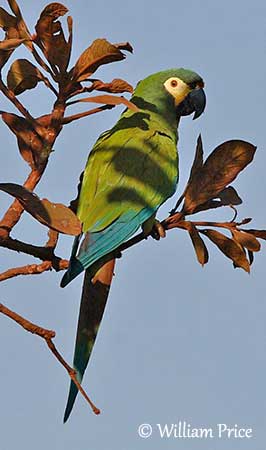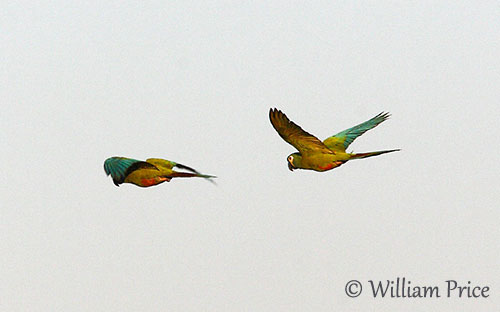
REPRODUCTION OF THIS SPECIES:
The breeding season in NE Brazil occurs from December to February, but mainly in December.
Like most Psittaciformes, the Blue-winged Macaw nests in cavities or holes in trees, often in Caraibeira tree (Tabebuia caraiba).
The female lays 2-4 white eggs and incubates during about 25 days. Both parents feed the chicks and the young start to fly about 11 weeks after hatching.
They remain within the family group for about one year after fledging, before to become independent.
PROTECTION / THREATS / STATUS:
The Blue-winged Macaw is heavily threatened by habitat loss due to deforestation, persecution as crop pest and illegal cagebird trade. However, the species occurs in several protected areas in Brazil. But the numbers are rapidly declining.
But the Blue-winged Macaw breeds well in captivity, and allows some hope for reintroduction in its native range.
The population is placed in the band 2,500-9,999 individuals, roughly rounded to 1,500-7,000 individuals.
The Blue-winged Macaw is currently classified as Near Threatened
The Fondation Loro Parque bred this species very well, and some birds from its breeding centre have been released in Bahia, Brazil as a pilot release for Spix’s Macaws. Text by Fondation Loro Parque – Tenerife (Waugh 1997).
Fr: Ara d'Illiger
Ang: Blue-winged Macaw – Illiger’s Macaw
All: Blauflügelara
Esp: Guacamayo Maracaná
Ita: Ara aliblu
Nd: Illigers Ara
Sd: blåvingad ara
Photographer:
William Price
PBase-tereksandpiper & Flickr William Price
Text by Nicole Bouglouan
Sources:
HANDBOOK OF THE BIRDS OF THE WORLD vol 4 by Josep del Hoyo-Andrew Elliott-Jordi Sargatal - Lynx Edicions - ISBN: 8487334229
PARROTS OF THE WORLD – An Identification Guide – by Joseph M. Forshaw – Princeton University Press – ISBN 0691092516
Arthur Grosset's Birds (Arthur Grosset)
Neotropical Birds – Cornell Lab of Ornithology
Wikipedia, the free encyclopaedia
Related article : Loro Parque Foundation and Parrots
Blue-winged Macaw or Illiger’s Macaw
Primolius maracana
Psittaciformes Order – Psittacidae Family
INTRODUCTION:
The Blue-winged Macaw or Illiger’s Macaw is known to live in the same area as the Spix’s Macaw (Cyanopsitta spixii), and the last wild male Spix’s Macaw was paired with a female of this species and both produced a hybrid embryo.
The Blue-winged Macaw is found in central and eastern South America, especially in E and S Brazil, with an isolated population in NE Brazil. It frequents evergreen and deciduous forests where it feeds on seeds and fruits from several plant species.
It is resident and can be seen in pairs or in small groups. It typically nests in tree holes like most Psittaciformes.
The Blue-winged Macaw is mainly threatened by deforestation, but persecution as crop pest and cagebird trade involve continuing decline, and the species is currently listed as Near Threatened.
The second name of this species pays tribute to Johann Karl Wilhelm Illiger, a German ornithologist.

DESCRIPTION OF THE BIRD:
Biometrics:
Length: 36 - 43 cm
Weight: 245 - 265 g
The Blue-winged Macaw adult has green mantle and rump, with red patch on lower back. On the wings, the flight feathers are blue, giving the bird its name. The graduated tail is blue, with broad reddish base.
On the underparts, throat, breast and upper belly are green, like undertail and underwings coverts. The lower belly is red. Flight feathers and undertail feathers are bronze-green.
On the head, the forehead is red, whereas crown, nape and lower cheeks are greenish-blue.
The heavy, hooked bill is black. The eyes are reddish-orange, surrounded with bare yellowish skin on cere, lores, eye-ring and upper cheeks, extending to ear-coverts area. Legs and feet are yellowish.
Both sexes are similar.
The juvenile has paler forehead and brown eyes. The patches on both belly and lower back are rather yellowish than red. The tail is shorter. It reaches its sexual maturity at 2 to 4 years.
RANGE:
The Blue-winged Macaw has a wide range in Brazil (north-east, centre and south-east). It is patchily distributed in E Paraguay and in NE Argentina where it is now probably extinct.
HABITAT:
The Blue-winged Macaw lives in the margins of evergreen and deciduous forests along water or bordering savannahs, and in gallery forests with Tabebuia trees along streams, in “caatinga” vegetation (thorny vegetation). It can also be found at forest edges up to 1,000 metres of elevation, and in palm groves.
CALLS AND SONGS : SOUNDS BY XENO-CANTO
Blue-winged Macaw utters sharp, shrill “krek…krek…krek” in flight, and a rolling “graaa”.
BEHAVIOUR IN THE WILD:
The Blue-winged Macaw feeds on seeds, fruits, flowers and palm nuts. It feeds on seeds provided by both native and introduced plants species. It can be seen on coffee bushes (Coffea arabica), and also consumes exotic fruits from Melia azedarach.
The Blue-winged Macaw is resident in its range. It is more secretive than other large macaws, and less noisy.
This macaw is usually seen in pairs or in small family groups. They gather at night in large flocks at communal roosts in trees.
These macaws can be extremely active, flying over landscapes at mid-height and landing into vegetation or isolated trees, mainly in the morning. These isolated trees provide them good visibility.
The Blue-winged Macaw is an artistic flier able to perform aerobatics. It flies with peculiar jerky upwards movements. This macaw prefers to fly along tree-lined streams, rather than across open areas.
